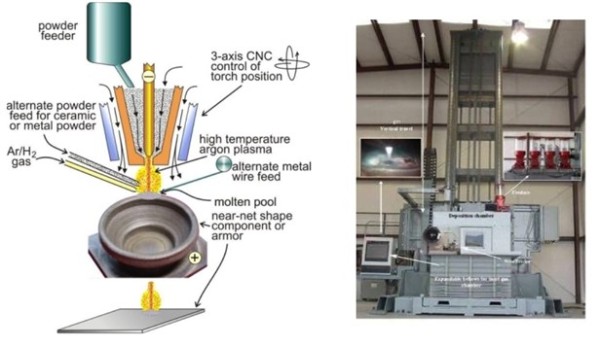
Plasma-Process
The Plasma-Process is a solid freeform fabrication (SFF) process. The subject of SFF has received great attention as it is now possible to make near-net-shape components from a CAD data-file. SFF requires a CNC controlled unit and a material source, mostly powder or wire. The heat source can be an electron beam, laser or a plasma torch. However laser or electron beam based heat sources have a very low built up rate to max. 1.5Kg/h. Especially Laser based systems are very expensive.
To overcome the problem of the low built up rate and to reduce cost, the plasma-process was developed.
This process is a breakthrough for the production of low-cost high performance Titanium components.
Fig. 1: Schematic of Plasma-Process
Plasma-process features:
-
High built up rates depending on the number of torches up to 100Kg/h. Even higher rates can be obtained with multiple torches.
-
This outperforms ANY other ALM (Additive-Layer-Manufacturing) process.
-
No Vacuum required compared to other ALM-processes.
-
The cost of a plasma torch is significantly lower compared to electron beam or laser based systems.
-
The material source can be powder or wire. Especially for the plasma-process a very low cost, high quality powder was developed.
-
High quality, high performance titanium components can be produced for low-cost levels that cannot be reached with other SFF and even wrought processes.
-
The plasma-process can produce a wide range of alloys as the melting process within the plasma is very effective. Alloys containing heavy or very light alloying elements can be processed because of the small melting pool, much safer compared to conventional processing.
-
The plasma-process is very effective for plate and sheet production as it can work with multiple plasma torches.
-
A total of four powder and one wire feeders can produce alloys and metal-matrix-composites.
-
Short delivery time of complex structures made of a range of Titanium and Titanium-MMC alloys.
Fig. 2: Microstructure of plasma-Processed Ti-6Al-4V.
Fig. 3: High modulus Titanium Conrod forging made from plasma-processed rod.
Alloys
Plasma-processed parts show higher strength, equal or higher ductility compared to conventional processing. Virtually unlimited alloying possibilities can generate high strength and low-cost Titanium alloys. Titanium composites, reinforced with TiC or TiB, can show reinforcement levels of 0-80%. From an engineering perspective reinforcement levels of 2-12% are useful because of the lower ductility. Very high levels of 30-60% reinforcement are usually for armor or wear resistant application. However high reinforcement levels are also used for Brake Disc application form 30-60% SiC in an Aluminum matrix. The processing of Al-SiC reinforced parts is much easier compared to Sinterprocessing.
|
Alloy |
Unit |
Ti-6Al-4V |
Ti-6Al-4V |
Ti-Al-V-Cr |
Ti-Al-V-Cr |
Ti-Al-Fe-B |
g-Ti-Al |
|
|
|
Wrought |
Plasma |
HT1-Plasma |
HT2-Plasma |
Plasma |
Plasma |
|
UTS |
MPa |
1.020 |
1.105 |
1.540 |
1.356 |
1.245 |
540 |
|
YS |
Mpa |
910 |
1.010 |
1.435 |
1.290 |
1.160 |
470 |
|
Elongation |
% |
12 |
14 |
4 |
7 |
4 |
1-2 |
|
Modulus |
GPa |
114 |
114 |
122 |
122 |
152 |
172 |
Fig. 6: Properties of Plasma-Processed Titanium alloys.
Cost
The plasma process can use a wide range of Titanium powders or wires. However especially for the plasma process a low-cost Titanium powder was developed. Bulk Titanium parts can be made for 6-15 Euro/Kg. This is only one third of the price for conventional processed semi-finished Titanium material.





